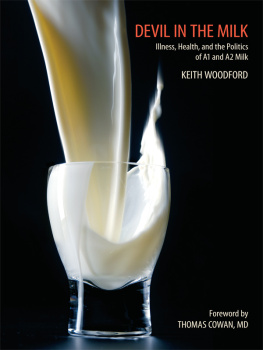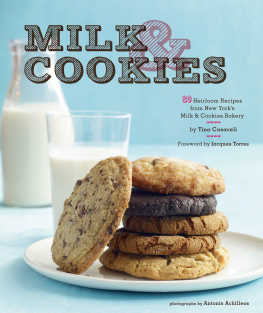Thank you for buying this ebook, published by NYU Press.
Sign up for our e-newsletters to receive information about forthcoming books, special discounts, and more!
Sign Up!
About NYU Press
A publisher of original scholarship since its founding in 1916, New York University Press Produces more than 100 new books each year, with a backlist of 3,000 titles in print. Working across the humanities and social sciences, NYU Press has award-winning lists in sociology, law, cultural and American studies, religion, American history, anthropology, politics, criminology, media and communication, literary studies, and psychology.
NATURES PERFECT FOOD
NEW YORK UNIVERSITY PRESS
New York and London
2002 by New York University
All rights reserved
Library of Congress Cataloging-in-Publication Data
DuPuis, E. Melanie (Erna Melanie) 1957
Natures perfect food : how milk became Americas drink/
E. Melanie DuPuis
p. cm.
Includes bibliographical references (p. ).
ISBN 0-8147-1937-6 (cloth : alk. paper)
ISBN 0-8147-1938-4 (paper : alk. paper)
1. MilkHistory. 2. MilkSocial aspects. 3. Dairy industry
United StatesHistory. 4. Food habitsUnited StatesHistory.
United States. I. Title.
GT2920.M55 D86 2001
641.3710973dc21 2001004677
New York University Press books are printed on acid-free paper,
and their binding materials are chosen for strength and durability.
Manufactured in the United States of America
10 9 8 7 6 5 4 3 2 1
Acknowledgments
A number of years ago, it became clear to me that I could spend the rest of my life writing this book. There remain many topics worth covering in more depth than I have in these pages. Milk, as many people who study it have told me, is a black hole that sucks you in and never let you escape. The real truth is that people who study milk never want to escape because the topic is endlessly fascinating. In the end, though, I realized that this book is as much about perfection as it is about food, and the book was done when I said what I had to say about American ideas of perfection using milk as a lens.
Using milk as a lens required, of course, reliance on that small but expert group of people whose profession is to think about and talk about milk. I have relied on these experts to help me understand what Americans have said and done to make this food over the last 150 years. For this I have relied heavily on Andrew Novakovic, James Pratt, and other dairy economists at the Cornell Department of Agricultural Economics (now the Department of Applied Economics and Management) in the interpretation of dairy efficiency studies and the untangling of the dairy regulatory system. While this book critiques the studies that came out of Cornells Agricultural Economics Department, I certainly cannot criticize the careful attention given to me when I needed to clear up some confusion. In fact, my conversations with the earlier generation of agricultural economists at Cornell, particularly Bob Stanton and Harold Conklin, were what put me on the path of investigating milk from an environmental and political perspective. In California, Bees Butler helped me untangle that states unusual dairy regulatory system. Harvey Jacobs and Jess Gilbert in Wisconsin sent me in some very valuable directions on the issue of land use planning and agriculture.
Of all my conversations with experts, the most fruitful were with Gould Colman, Cornells University Archivist for many decades. He would answer my questions with a box, that is, a box in the archives I should look through to get my answers. He was the one who pointed me toward history, telling me that if I understood the history, I would understand how the human hand had a role in creating the present.
I must also thank David Barnett, committee assistant for the Assembly Agriculture Committee for the New York state legislature. As an intern in his office, I was the involuntary audience for many vocal phone conversations during Davids negotiation of dairy legislation. My conversations with David made me realize the depth, richness, and mystery of dairy regulation.
There were a number of sociologists involved in studying dairying at the Department of Rural Sociology at Cornell during my own work there. My early work with Chuck Geisler on rBGH made me realize that the relationship between technological change and economic development in the dairy industry was not cut and dry. My dissertation advisor, Tom Lyson, and I worked together for many months, seeking a framework that would help us articulate the vast differences in dairy practices carried out by New York state farmers. Another member of my dissertation committee, Susan Christopherson, was the first to stop short in the hall during one of our conversations on my dissertation and say, But the most interesting question is why we drink this stuff in the first place.
In the area of temperance and social reform in the nineteenth century, a three-hour phone conversation with Harry Levine helped steer me into more balanced waters. The interactive reviews in the Web pages of H-Rural were invaluable sources for the various perspectives on agrarian populism. I am truly grateful for what that mailing list has taught me about rural history.
To Linda Layne and the Social Studies of Science Department at Rensselaer Polytechnic Institute, I owe the opportunity of spending a postdoctoral year investigating the history of milk drinking. The members of that department freely shared their thoughts and skills, providing me with the tools necessary to look beyond political economy. I owe another huge debt to David Goodman, Margaret Fitzsimmons, Bill Friedland, Patricia Allen, and the rest of the Food Systems Study Group at University of California, Santa Cruz, who patiently sat through and responded to presentations of early chapter drafts. This study group continues to provide me with ongoing, lively conversation about the sociology of agriculture.
I must also thank my terrific research assistants, Jennifer Snedecker, Jeannette Simmonds, Michael Schneidereit, and Allison Fletcher, who I always kept sending to the library for more and who always came back with more. In writing this book I returned again and again to the written exegeses they supplied me with, covering the literature on breast-feeding, natural theology, nineteenth-century diet, and other topics. They became so well acquainted with the literature that they ended up gently arguing me out of certain conclusions and into other ones. Librarians Mildred Pechman and Arlene Shaner, of the New York Academy of Medicine, helped me comb through archives of milk ephemera.







